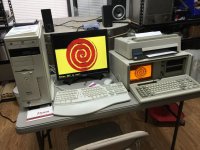tipc
Banned
http://www.ebay.com/itm/Vtg-IBM-PGC...D&orig_cvip=true&rt=nc&_trksid=p2047675.l2557
Wow. I sold a working one _and_ the 5175 monitor for about 160$ on eBay a few back. I think I should have held onto it.
Still have the working card and a non-working monitor. Are these things going to keep going up? There has to be a ceiling, such a relatively small number of collectors. But no one guess a baseball card or comic book would ever be worth 1M$, so who knows.
Also have the uber rare Vermont Microsystems clone. A few others made clones. Come to think of it the VM card may have an 80188. Now isn't that interesting.
what would you pay for a complete working PGC card? If I didn't have one, and at this point were in the market, I may go as high as 200$. That's on a good day (for the seller). Card and monitor? Maybe 300$. Again on a good day.
Wow. I sold a working one _and_ the 5175 monitor for about 160$ on eBay a few back. I think I should have held onto it.
Still have the working card and a non-working monitor. Are these things going to keep going up? There has to be a ceiling, such a relatively small number of collectors. But no one guess a baseball card or comic book would ever be worth 1M$, so who knows.
Also have the uber rare Vermont Microsystems clone. A few others made clones. Come to think of it the VM card may have an 80188. Now isn't that interesting.
what would you pay for a complete working PGC card? If I didn't have one, and at this point were in the market, I may go as high as 200$. That's on a good day (for the seller). Card and monitor? Maybe 300$. Again on a good day.


